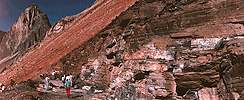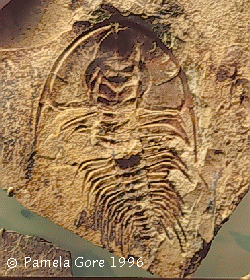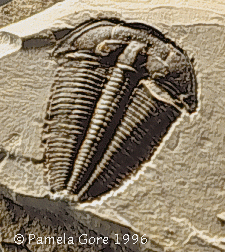 |
| Continental Locations - Late Cambrian Period (514 Ma) |
- At the beginning of the Cambrian period, Rodinia began to fragment into smaller continents.
- These continents do not always correspond to the continents we see today.
- Continents distributed within 60 degrees of the paleoequator.
- Tibet, Southeast Asia (Indochina and Malaya), Arabia and other parts of the Near East were all part of a large supercontinent in the Southern Hemisphere known as Gondwana land.
- Gondwana also included Africa, Australia, Antarctica, and South America.
- The dispersal of continents in the Cambrian is a result of the fragmentation of Rodinia.
- Also, during the Cambrian period major rock formations were forged. Many of these forms remain visible today.
Extinction Events
- There were many small-scale, sporadic extinction events during the Cambrian Period.
- A large-scale mass extinction event occurred approximately 500 million years ago.
- Scientists believe was caused by a significant decrease in global temperature.
- Decrease in global temperature created an ice age - further eliminated many of the oceanic species.
- Also due to glaciating events that lowered and cooled global sea level making it impossible for many organisms to live.
Two Hypotheses for the effect glaciating could have had on existing organisms are:
1) Evidence of continental glaciating at the Cambrian-Ordovician boundary is hypothesized to be responsible for a decrease in climatic temperatures. It is speculated that glaciers would have:
- Caused a trapping of ocean water as ice.
- Which caused a decrease of sea level.
- Withdrawal of shallow seas.
- Left organisms dry and without habitat.
2) The second hypothesis is that the:
- Cooling
- Oxygen depletion of oceanic waters
- Led to the elimination of all organisms that were not able to tolerate cool oxygen poor conditions.
Fossil Record
Rocks of Cambrian age are distributed in the Great Basin (the largest desert in the US) of the western United States, parts of the northeastern United States, Wales, Scandinavia and the Baltic region, Siberia, and China, among other places. These localities were not where they are now: the position of the continents was very different (see Continental Drift).
- Aldan River - Lower Cambrian fauna from this site in Yakutia, Siberia, trace the earlyevolution of animals with skeletons.
- Burgess Shale - One of the greatest fossil finds ever found is the Burgess fauna of British Columbia. These types of fossils help us to see what early marine life might have been like.
- House Range, Utah - A wide variety of Cambrian critters have been found in the Wheeler Shale and the Marjum Formation, both of which are found in the House Range.
- Marble Mountains - In the hottest part of the Mojave Desert of California is the rich Latham Shale where trilobites are numerous.
- White-Inyo Mountains - Ancient reefs in the mountains of eastern California, which contain much early marine fossils. (http://www.ucmp.berkeley.edu/cambrian/camb.html)
 |
| Burgess Shale Formations |
The major authorities in primary literature on this geologic period:
- Philip W. Signor, Susan M Kidwell, M.J. Benton, and John L. Cisne to name a few.
Adaptive Radiation
At the beginning of the Cambrian period, about 570 million years ago,
- higher life was entirely confined to the oceans During the 60 million years that the Cambrian period lasted there was the
- Sudden appearance and diversification of almost every major group (phylum) of animal life, as well as many types that later died out.
- Animals with shells and exoskeletons appeared for the first time, including trilobites, brachiopods, mollusks, and many other groups. This sudden evolutionary burst was so spectacular that it has been termed the "Cambrian explosion." There hasn't been anything like it on Earth before or since.
Possible explanations for the Cambrian Explosion are:
- The significant quantity of oxygen that was mixed into the world's oceans. This made dissolved oxygen available to the diversity of aquatic animals, and may have triggered the explosion.
- Hox Genes allowed for cells to b identified by their location in relation to other cells for segmentation, symmetry and body organization. Have been found in all major phyla excluding sponges located in close proximity to one another.
- Research as to the time of origin of Hox genes is still in process
- Gene duplication and loss of Hox gene complexes has led to the diversification of HOX gene complexes through time
I) Animal Diversity:
A) Hard-bodied
- The most characteristic animals of the Cambrian period were the trilobites, a primitive form of arthropod remarkable for it's highly developed eyes (unusual in such an early organism) and their exoskeletons of chitin. The trilobites reached their fullest development in the middle Cambrian
 |  |
| Trilobite fossil 1 | Trilobite fossil 2 |
B) Soft-bodied
- Other very important groups of Cambrian animals were the sponges, echinoderms
- The most interesting of all the soft-bodied animals were the echiurians, which were burrowing worm-like creatures, which seemed to have been the most important and predominant carnivores of the time.
C) Gastropods
- The earliest gastropods (marine snails) also appeared in this period, as did the cephalopods (during the late Cambrian) and other now extinct lineages of Molluscs. Molluscs however were still relatively rare; they did not become an important element of the marine fauna until the early Ordovician period.
D) Other Forms
- The first chordates (vertebrate ancestors) occurred
- Reduction of oxygen-depleting bacteria - enabled oxygen to accumulate in the atmosphere to exhibit the high levels experienced today
- Many Cambrian creatures however did not fit into modern categories of organisms; they seemed to have been representatives of unknown or experimental phyla.
II) Microbial Diversity
- Many unicellular organisms were preserved as microfossils.
- A great many of these fossils are of uncertain systematic classification, not recognizable as relatives of any particular living species
- Other unicellular organisms found include bacteria, cyanobacteria, dinoflagellates, and other protists
III) Plant / Algal Diversity
- Increase in photosynthetic algae
- Multi-cellular organisms, with larger metabolic rates
Glossary of terms
- The spread and diversification of organisms into newly opened ecological niches
- A group of clam-like marine invertebrates separated into two categories based on shell morphology - Geologic Range: Cambrian to Recent.
- Deposits of fine particulate sediment - dated to 520- 515 Mya Large deposits near Alberta and British Columbia First discovered by Charles D Walcott Probably the most famous type of fossil containing rock for this period.
- Large "explosion" or radiation that gave rise to a seemingly spontaneous origin for a large majority of the Earthıs genera.
- Nitrogenous-sugar polymers comprising a hard exoskeleton.
- Division of the Precambrian eon from 2.5 to 0.56 Ga.
- Late Proterozoic supercontinent.
- Marine arthropods with a chitinous or calcareous exoskeleton. Geologic Range: Cambrian to Permian.
- Adaptive radiation
- Brachiopods -
- Burgess Shale
- Cambrian Explosion
- Chitin
- Proterozoic
- Rodinia
- Trilobites -
Literature Cited:
- Condie, Kent C. and Sloan Robert E. 1998. Origins and Evolution of Earth: Principles of Historical Geology. Upper Saddle River, NJ: Prentice Hall.
- Cowen, Richard. 2000. History of Life, 3rd edition. Malden, Massachusetts; Blackwell Science, Inc.
- Freeman, Scott and Herron, Jon C. 1998. Evolutionary Analysis. Upper Saddle River, NJ: Prentice Hall.
- http://www.ucmp.berkeley.edu/cambrian/camb.html
- http://hannover.park.org/Canada/Museum/extinction/cammass.html
- http://www.kheper.auz.com/gaia/Paleozoic/Cambrian/Cambrian.htm
- http://www.britannica.com/